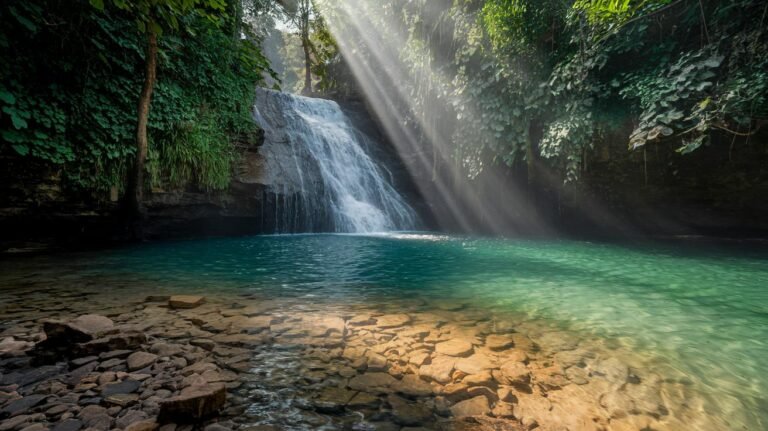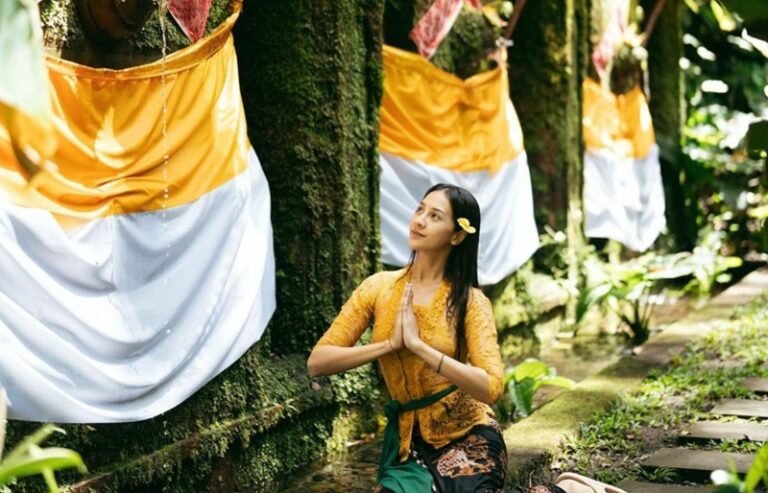7 Off the Beaten Path Temples in Ubud Inspire Serenity
Ever wondered what lies beyond Ubud’s crowded temple gates? Slip along hidden jungle trails ringed by frangipani blooms (plumeria flowers with a sweet scent) and rice terraces (stepped fields that glow emerald at sunrise). And breathe in the warm, earthy air as mossy stones guide your steps.
You’ll discover seven off-the-beaten-path temples that feel like whispered invitations to calm.
Picture water blessings (gentle sprinkles that wash away travel weariness), shrines carved into misty cliffs, and secret pools so still you can almost hear your own heartbeat.
Pure bliss. These trails are quiet – no tour buses, no guidebooks. Just you, the jungle, and the soft murmur of hidden waterfalls. Ready to wander where the crowds can’t follow?
Hidden Ubud Temples: Top Off the Beaten Path Sanctuaries

Ever dreamed of slipping into a secret shrine? Tucked beyond buzzing markets lie temples nestled in rice terraces (stepped fields that glow emerald at sunrise) and jungle clearings. You’ll wander narrow lanes framed by frangipani blossoms (plumeria flowers with a sweet scent) and stumble onto stone shrines that feel like a whispered invitation.
These hidden Ubud temples bring a gentle calm. Far from the crowds you can hear the soft murmur of trickling water, watch tiny offerings float on temple ponds, and feel centuries of tradition settle around you. Pure bliss.
Each spot has its own simple ritual. Some invite you to join a water blessing to wash away travel weariness. Others reveal cliff-carved shrines you’d swear were made by giants. Next, a quick peek at our favorite secret sanctuaries.
| Temple Name | Distance from Ubud | Opening Hours | Entrance Fee | Access Tip | Noteworthy Feature |
|---|---|---|---|---|---|
| Pura Gunung Kawi Sebatu | 10 km | 8 am – 6 pm | 50,000 IDR | hidden temple tours in Bali – gravel road | Water-purification pools |
| Goa Gajah | 6 km | 7 am – 5 pm | 50,000 IDR | hidden temple tours in Bali – forest path | 9th-century carvings |
| Pura Gunung Lebah | 4 km | 7 am – 6 pm | Fee by donation | hidden temple tours in Bali – dirt trail | Batur-goddess reliefs |
| Pura Gunung Kawi Rocky Temple | 13 km | 8 am – 6 pm | 50,000 IDR | hidden temple tours in Bali – steep steps | 10 cliff shrines |
| Tirta Empul | 15 km | 9 am – 5 pm | 50,000 IDR | hidden temple tours in Bali – paved road | Holy spring baths |
| Pura Samuan Tiga | 8 km | 8 am – 6 pm | 50,000 IDR | hidden temple tours in Bali – narrow lane | Hilltop rice-field views |
Rent a scooter (um, a motorbike) or hire a local driver who knows the back lanes. You’ll want a simple map or your phone’s GPS app since some lanes don’t have signs. Pack plenty of water and slip on a sarong (a cloth wrap guests often get at the entrance) to show respect. Or if you’d rather skip the route-finding, try a guide. Early mornings give you full quiet hours in these offbeat temples. Ready to wander?
Off the Beaten Path Temples in Ubud: Local Etiquette and Practical Tips

Ever wander down a quiet lane in Ubud and spot a tiny temple peeking through the palms? That gentle hush you hear is the heartbeat of local faith. Here’s how to step in with curiosity and care.
- Dress right. Slip on the sarong wrap (waist cloth) at the entrance to cover your shoulders and legs.
- Lower your voice near shrines and tread lightly around the canang sari (flower offerings).
- Skip the camera flash in inner chambers and ask before photographing worshippers.
- Try to arrive at opening time (9 am) or late afternoon to share the space with fewer people.
- Have about 50,000 IDR ready for the entrance fee that keeps these temples cared for.
- Women on their period traditionally sit out rituals, a gentle nod to local customs.
Pause. Breathe in the soft scent of frangipani and incense mingling with warm stone. You’ll feel the hush of prayers echoing off carved walls. Watching how each offering rests in perfect balance brings a quiet wonder.
Entrance-Fee Policies and Preservation
Every 50,000 IDR you pay helps paint fresh murals, polish carved doors, and tend the lotus pond by the shrine.
By sticking to the main paths, you support guides and craftsmen who keep these temples alive.
That fee even covers the sarong wraps and canang sari baskets so you arrive ready to honor the tradition. Your visit turns into real care for these sacred hideaways.
Cultural Significance of Off the Beaten Path Temples in Ubud

Many of Ubud’s hidden shrines were built between the 8th and 11th centuries and show how Hindu and Buddhist art blended on Bali long ago. You’ll spot sturdy stone walls and weathered reliefs that speak of priests and pilgrims who walked these paths centuries before. Moss and ferns soften the carvings, as if nature joined the builders in crafting each temple. Some shrines wear frangipani offerings like little crowns, reminding us that beauty and devotion have always gone hand in hand. It feels like stepping into a living museum where every carved niche holds a memory.
Water sits at the heart of island worship with Pura Gunung Kawi Sebatu and Tirta Empul offering gentle purification ceremonies. Cool spring water flows over your hands and shoulders as you move from one spout to the next, a ritual that traces back to ancient holy-spring beliefs. At Goa Gajah and the cliff-cut Gunung Kawi Rocky Temple, carved figures of local gods and mythic scenes peer out from stone faces and niches. These images once guided villagers through seasons of planting, harvest, and prayer.
Village life pulses around these sanctuaries with daily canang sari (flower offerings) placed before each altar. You might see elders arranging petals in perfect patterns while children giggle by a lotus pond. And each prayer feels woven into the rhythms of daily chores, as sacred moments slip gently into everyday life.
Best Times to Visit Off the Beaten Path Temples in Ubud

Slip out at sunrise, when the temple gates yawn open and the day is still hush. Imagine dew clinging to mossy steps (like tiny emerald jewels), the first wisp of incense drifting through ancient stone halls, and soft dove coos echoing above weathered lintels. Pure bliss.
Midday brings a different beat. Head to Goa Gajah’s purification pools (holy water baths used for blessing) and you’ll find friendly locals gathered for prayer and quiet chatter. It’s a warm community moment before you sneak away to your own peaceful wander.
Afternoon showers can feel like a gift. Gentle drizzles soften each footfall, cool the carved walls, and wash the stone till details pop. Right here, just you and the patter of rain.
By the way, if you’re chasing festival magic, keep an eye on the local calendar for Odalan ceremonies (temple anniversaries). Shrines might close for rituals and processions, and you’ll need the right sarong or a small offering. But those vibrant dances and fragrant flower gifts are a window into true village devotion.
Plan to visit just before or after the celebrations. In those sweet spot hours you’ll enjoy quiet meditation, crisp photos, and the temples all to yourself.
Sample Off the Beaten Path Temple Itineraries in Ubud

Ever dreamed of a half-day temple hop in Ubud? Let’s start at 8:00 AM at Pura Gunung Kawi Sebatu. Slip into a gentle water blessing (holy spring water over mossy stones) and feel your spirit wake. Then grab a scooter (just like the locals) and glide down narrow lanes for about 15 minutes. By 10:00 AM you’ll reach Goa Gajah, the “Elephant Cave,” where 9th-century carvings and a secret meditation grotto invite quiet reflection. At noon, you’ll arrive at Pura Gunung Lebah at the end of Campuhan Ridge Walk (a lush path through swaying palm fronds). Watch the midday sun play across the goddess Batur reliefs. Each shrine asks for about 50,000 IDR and usually lends you a sarong, so you can travel light.
- Scooter rental: ≈60,000 IDR/day
- Road tips: narrow rural lanes • slippery after rain
Next, if you’ve got a full day to explore, meet us at Tirta Empul at 8:00 AM. Slip into the cleansing pools fed by a sacred spring (think natural spa). By 10:30, descend into Gunung Kawi “Rocky Temple” (stepped shrines carved into a cliff). Around 12:30, pause for lunch at a cozy warung (local cafe) tucked between rice terraces (stepped fields that glow emerald at sunrise). Savor nasi campur with the tang of fresh sambal. At 2:00 PM, wander into Goa Gajah’s forested grounds, listen to birds and peek at its hidden purification baths. Finish at 4:00 PM at Pura Samuan Tiga, where golden light spills over hilltop rice fields. Pure serenity.
- Scooter rental: ≈50,000 IDR/day
- Road tips: narrow rural lanes • slippery after rain
Accommodation Options Near Off the Beaten Path Temples in Ubud

Village homestays tucked along Ubud’s winding countryside paths feel like an old friend’s invitation. In Nyuh Kuning you’ll wander rice terraces (stepped fields that glow emerald at sunrise) with farmers and slip into tiny roadside shrines just steps from your bamboo-walled room. Sibetan’s lodgings sit beside Salak fruit groves (clusters of round, reddish fruit) where early birdsong mingles with soft temple chants drifting over the hills. Pure bliss.
These spots feel like a nod from the village elders, you might linger longer than planned. I’d pick at least three nights so you can tiptoe out before dawn and discover hidden temples in the mist.
If you’re craving more pampering, Blue Karma Dijiwa sits among emerald rice terraces, with scooter rides of about 15 minutes to secret shrines. Many of our luxury villas in Ubud come with private chefs who’ll deliver coconut-scented breakfasts and pack custom trail lunches for your temple trek. You’ll find scooters ready in-villa and a concierge map marking the narrow dirt lanes to Pura Gunung Kawi Sebatu and Tirta Empul.
Each villa blends modern comfort with Bali’s rural charm: think thatch-roofed pavilions and hand-carved doors so you feel right at home while chasing sunrise rituals. Ever dreamed of stepping into a living painting? Oops, let me rephrase that. Tranquility. Right here.
Final Words
We began by exploring six hidden sanctuaries. Then we covered respectful visit guidelines and fee policies.
We uncovered temple history, water rituals, and the best times to pause for meditation. Sample itineraries offered half-day loops and full-day plans with meal breaks.
You’ll find transport tips, local customs, plus cozy homestay and villa picks. Ready to step beyond crowded spots? A world of serene rituals and lush stone reliefs awaits in those off the beaten path temples in Ubud. Pure bliss.
FAQ
What are the best off the beaten path temples in Ubud?
The best off the beaten path temples in Ubud include Pura Gunung Kawi Sebatu, Goa Gajah cave shrine, Pura Gunung Lebah at Campuhan Ridge, Gunung Kawi Rocky Temple, and the holy pools at Tirta Empul.
How can I take a tour of off the beaten path temples in Ubud?
You can take a tour of off the beaten path temples in Ubud by booking through local guides who offer small-group pickups and gentle scooter or car transfers along quiet rural lanes.
What are some non-touristy, free, and unique things to do in Ubud?
Non-touristy, free, and unique things to do in Ubud include wandering emerald rice terraces at sunrise, strolling the Campuhan Ridge Walk, exploring artisan markets, visiting community art studios, and joining public temple ceremonies.
Where can I find hidden gem restaurants in Ubud?
You can find hidden gem restaurants in Ubud by exploring warungs off Jalan Raya Ubud—like Sawobali Vegetarian Warung—or tucked-away beach-clay spots, and following local word-of-mouth for cozy farm-to-table meals.
What should I be careful of in Ubud?
Be careful of uneven footpaths on rural trails, busy traffic on narrow roads, sudden rain showers at higher elevations, and respect temple boundaries by not stepping on canang sari offerings or entering restricted areas.
Why is Ubud so spiritual?
Ubud is spiritual because its temples date from the 8th–11th centuries, daily canang sari flower offerings fill every shrine, and its lush jungle setting invites meditation, healing rituals, and Balinese Hindu devotion.
What can I do in Ubud at night and is it safe to walk around?
You can enjoy live gamelan music at open-air cafes, wander Ubud Palace plaza under lantern glow, or sample night market treats. Walking at night is generally safe—stick to well-lit streets and stay alert to passing scooters.







